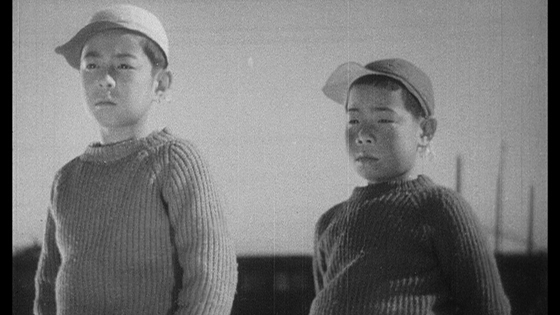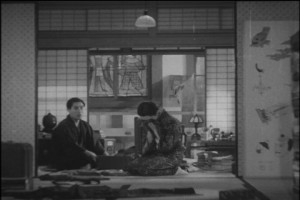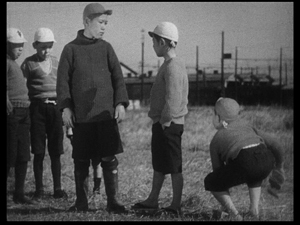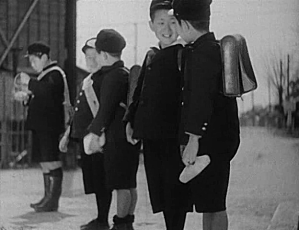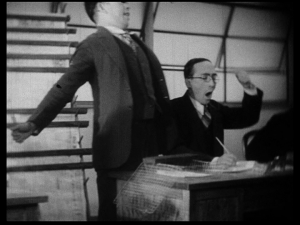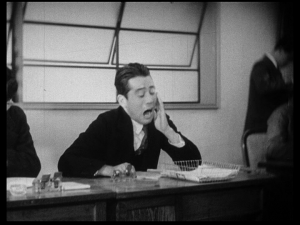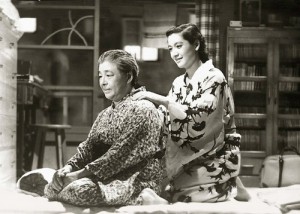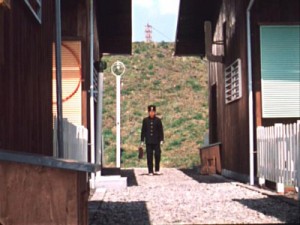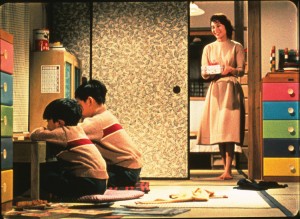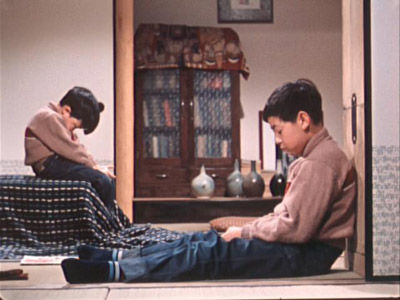The following is a lecture delivered at a symposium, “Yasujiro Ozu in the World,” organized by Shigehiko Hasumi in Tokyo on December 11, 1998. The other participants, apart from Hasumi himself, were Jean Douchet (the keynote speaker), Hou Hsiao-hsien, his screenwriter Tien-wen Chu, and Thierry Jousse. I’m proud to say that Hasumi, my favorite contemporary film critic, has included a link to this text on his own web site, mube.jp. — J.R.
I’d like to preface these remarks by citing a moment from Ozu’s I Was Born, But… (1932) and the particular significance it has for me. During the home movie projection which marks the critical turning point in the film from comedy to tragedy, and shortly before the clowning of the father in front of his boss appears in one of the home movies, the father’s two little boys start having a debate about the zebra they see on the screen — does it have black stripes on white, or white stripes on black? — creating a disturbance that momentarily halts the screening. In comparable fashion, a spurious, distracting, and no less innocent debate has been persisting about Ozu for years: is he a realist or a formalist? What seems lamentable about this debate is that it fails to perceive that cinematic forms and social forms are not alternatives in the world of Ozu but opposite sides of the same coin, so that it should be impossible to speak about one without speaking about the other. I regard this fact as the linchpin of my argument, and I hope that the remainder of my discussion essay will bear this out.
I was recently having dinner at one of my favorite Chinese restaurants in Chicago, where the waiter happens to be a passionate cinephile. While taking my order, the waiter was telling me about his enthusiasm for Tsai Ming-liang, and when I mentioned that I would be speaking shortly about Yasujiro Ozu in Tokyo, he said to me, “I don’t know about Ozu. His films are so slow.” The following remarks are an attempt to respond to his comment.
My first response is to say that some of Ozu’s silent films — in particular I Was Born, But…, one of my favorites — aren’t very slow at all, and it’s symptomatic of the limitations of global film culture today that silent cinema is often ruled out of order in advance. But my second response is to ask what we mean when we call a film slow — an adjective that’s frequently pejorative, even when it’s used in relation to films by Robert Bresson, Carl Dreyer, Hou Hsiao-hsien, Abbas Kiarostami, F.W. Murnau, Ozu, Jacques Rivette, Jean-Marie Straub and Danièle Huillet, Andrei Tarkovsky, and Jacques Tati, among others. And to pose this question with particular reference to Japanese culture, I’d like to introduce a couple of hypotheses.
One of these hypotheses comes from a provocative short essay by Karlheinz Stockhausen called “Ceremonial Japan” that I first read in the Times Literary Supplement a quarter of a century ago (October 25, 1974, pp. 1189 & 1191). Exploring his fascination with a diverse variety of Japanese ceremonial forms — the Noh theater, Omizutori (the Water Consecration Festival), Sumo wrestling, and the tea ceremony — Stockhausen has the following to say about what he calls Japanese timing:
Where timing is concerned, the European is absolutely mediocre. Which means he has settled down somewhere in the middle of his range of potential tempi. It is a very narrow range, compared with the extremely fast reactions that a Japanese [person] might have at a certain moment, and to the extremely slow reaction that he might show on another occasion. He has a poor middle range compared to the European.
Stockhausen also implies that this distinction is in danger of being effaced or at least eroded by the Westernization and Americanization of Japan. This is a delicate matter, because we know from the persuasive arguments in Shigehiko Hasumi’s book on Ozu, Yasujiro Ozu (available in its entirety only in Japanese and French, though the beautiful final chapter, “Sunny Skies,” can be found in David Desser’s 1997 collection of critical pieces devoted to Tokyo Story published by Cambridge University Press), that Ozu’s work also reflects to some degree the impact of America on Japanese culture. But because Hasumi is a Japanese critic looking at American influence and I’m an American critic looking at Japanese elements, we see things with a somewhat different emphasis. In any case, I would like to suggest — and this is my second hypothesis — that the fast reactions in Japanese spectators implied in Ozu’s filmmaking practice often correspond to standing and walking, and that the slow reactions implied in his filmmaking practice often correspond to sitting.
What do I mean by this? The elements in I Was Born, But… that I identify as fast — in particular, the brevity of certain still shots of locations and the speed of certain camera movements — can be linked to either an implied standing spectator or an implied walking spectator, and when the camera movements follow characters who are walking, the speed of the characters and the implied speed of the spectators watching them are clearly linked. Furthermore, the elements in the film that I identify as slow mainly occur when characters are seated.
Now it’s obvious that most of us watch films while we’re seated. But just because it’s obvious doesn’t mean that it isn’t worthy of some reflection — and reflection, after all, is something else that’s often best done while we’re sitting. Yet the artificial sensation of speed that characterizes so much of contemporary commercial cinema, American cinema in particular — the speed of fast cars and explosions and what we call “action,” not to mention the speed of much TV editing, all of which tends to make Ozu seem “conservative” and “old-fashioned” by comparison — tends to deny this fact, to operate as if we were literally watching films on the run, without any opportunities for reflection.
Ozu’s acknowledgment that we watch films while sitting seems to me a fundamental aspect of his style, and a great deal that is considered difficult or problematical or simply “slow” in his style derives from this essential fact. As a rule, characters in Ozu films are seated when they eat and when they converse. In I was Born, But…, the two little boys who are the central characters are mainly seen on their feet, but early in the film they are seated when they have breakfast, when they put on their shoes before leaving their house, and then when they decide to skip school and have their lunch in a field. They are also seated when they attend school the following day, when they watch home movies at the home of the father’s boss, and later, after their fight with their father, when they refuse to eat. All of these occasions might be described as times of relative reflection.
But this is a film in which social behavior and social conditioning are at least as important as reflection, and the issue of speed is relevant to all three activities. Early in the film, after the boys skip school out of fear of getting beaten up and have their lunch in the field, one of the brothers reminds the other, “We’re supposed to get an A in writing today.” Soon afterwards they both stand up to finish their lunch on their feet, an action which implies, as much else in the film does, that getting ahead in the world requires alertness and motion, both of which are usually more obtainable from a standing position.
As if to demonstrate this point, the film then cuts to the other boys at school standing at attention in the school yard and following the instructions of a teacher to turn and then to march in a military fashion. The camera remains stationary during most of this activity, but then, as the boys march briskly past the camera from right to left, the camera begins to track rapidly in the reverse direction, from left to right. Then there is a cut to another rapid left-to-right track in the office where the boys’ father works — a famous shot moving at the same speed past workers at a row of desks, some of them seated and some standing. Each worker yawns as if on cue just as the camera passes him, except for one, until the camera moves back to him in the reverse direction, stops, and waits for him to yawn as well; as soon as he does, the camera resumes the same rapid left-to-right movement past other workers, all of whom yawn on cue. This is a rather exceptional modernist moment in Ozu’s work because it equates his own position of power as a director with the power of the state — specifically, with the power of the school and the office, the two principal zones of authority in the film apart from the more indeterminate zones of the field (ruled by the boys) and the house (ruled by the father). Significantly, it is in the field and in the house where conflict breaks out in the film —- not in the school or in the office, where the laws of behavior are more absolute — and by drawing a parallel based on speed and motion between the school and the office, and focusing comically in both locations on individuals who fail to conform, Ozu is providing a particular context for the conflicts that arise elsewhere.
Furthermore, by drawing an explicit parallel between the authority exerted by his camera and the authority exerted by the school and the office, Ozu is explicitly positing an important relationship between cinematic forms and social forms, a relationship that carries a great deal of meaning throughout his work.
***
In contrast to I Was Born, But…, Tokyo Story (1953) can correctly be identified as a slow film —- not because Ozu is imposing an external formal structure on his material but because the central characters he is concerned with are an elderly couple whose movements are slow, and who are seen sitting more often than standing. Somewhat faster movements are associated with their children in Tokyo who are too busy with their lives to spend much time with their parents, but on the whole this is a film geared more to the movements of the parents than to the movements of the younger generations. Significantly, the single element in the film that is most associated with speed — the trains that carry the parents from Onomichi to Tokyo, from Tokyo to Atami and back, from Tokyo to Osaka, and then from Osaka back to Onomichi — are never seen. The trains in motion that we do see are most often details in landscape shots that function rather like musical accents, comparable to the moving boats in the Onomichi harbor and the moth fluttering against a lamp while the mother is dying; these accents are emblems of speed and motion that serve to throw into relief the relative stasis that surrounds them.
The most pertinent exception to this rule is the moving train carrying Noriko, the parents’ daughter-in-law, back to Tokyo from Onomichi near the end of the film — a train viewed externally as the main focus of two successive shots before we see Noriko seated inside in the third, examining the mother’s watch that the father has just given her as a keep-sake. Time is a central preoccupation of Tokyo Story, which helps to explain not only why the ticking of a clock is one of the last things we hear on the soundtrack, but also why this speeding train and this watch are highlighted shortly before the end. If speed in I Was Born, But… is often associated with struggle and desperation because it plays against the slowness associated with reflection and recognition, speed in Tokyo Story becomes associated with hope in relation to the figure of Noriko, if only because we’re led to believe that she represents the possibility of change in relation to the future.
Judging by David Bordwell’s quantitative analysis of Ozu’s films, which appears as an appendix to his Ozu and the Poetics of Cinema (Princeton: Princeton University Press, 1988, p. 377), Tokyo Story is probably not Ozu’s slowest film. We learn from this chart that there are 1371 shots in I Was Born, But… and 786 shots in Tokyo Story, whereas There Was a Father (1942), which I’m less familiar with, is the surviving Ozu feature with the smallest number of shots, 353. Moreover, whereas the average shot length of I Was Born, But… is four seconds and the average shot length of Tokyo Story is more than two and half times longer, 10.2 seconds, the average shot length of There Was a Father is 14.8 seconds. I’m somewhat skeptical of how many generalizations can be reached through this kind of quantitative analysis, especially when it encompasses silent as well as sound films and when the presence of intertitles alters our sense of what a shot consists of. But one could at least surmise from Bordwell’s figures that Tokyo Story is typical of Ozu’s late manner without necessarily representing an extreme.
Yet at the same time, Good Morning (1959), another relatively late film, alters the rules of the game we have been playing up to now regarding speed. It contains 819 shots and has an average shot length of seven seconds, which would appear to make it slower than I Was Born, But… and faster than Tokyo Story. But in fact Ozu’s editing and mise en scène in Good Morning can’t really be assigned to that middle range of tempi described by Stockhausen, a range he argued that Japanese spectators are less comfortable with.
If, broadly speaking, I Was Born, But… can be characterized as fast and Tokyo Story can be characterized as slow, Good Morning can’t be properly described as either. More concerned with coexistence and interaction than with conflict and separation, it is in fact one of the most complex Ozu films in terms of rhythm and tempo. In most scenes one finds characters who are seated as well as characters who are standing, just as most of the “static” shots of locations also feature people walking past. There’s scarcely more “action” in this film than there is in Tokyo Story, yet the overall movement from character to character and from scene to scene is brisk throughout. Although I can’t speak with any authority about Japanese sitcoms in the 50s, I would imagine that they bear some resemblance to American sitcoms of the same period. If I’m correct about this, I would guess that Ozu is consciously borrowing from this form, which means that television is central not only to the plot of Good Morning but also to its narrative structure.
Despite many thematic echoes of I Was Born, But… in Good Morning, the two films are in fact quite different. Structured on the formal as well as social equivalence between schoolboy farting contests, the small talk of a couple, and the greetings between neighbors, and concerned with what might be called the architecture of everyday social interactions, Good Morning combines speed with slowness in numerous ways — not only in the overall progression of the narrative but in many individual details, such as the image of the younger brother playing with his hula hoop, which involves him standing relatively still and shaking his hips very rapidly at the same time.
One conclusion that can be drawn from this is that speed is relative — all the more so in a film where coexistence and relativity are central to the style as well as the subject. For this reason, we can’t answer the question, “Is Ozu slow?” in a single way. The work is too rich and too varied for such a question to have any meaning. Indeed, it’s part of the function of the greatest artists to dissolve such questions, or at the very least transform them into other questions. For what finally matters most in Ozu is not how slow or fast he is but how slow or fast we are in keeping up with him.
— Senses of Cinema (Australian web site), issue no. 4, 2000

